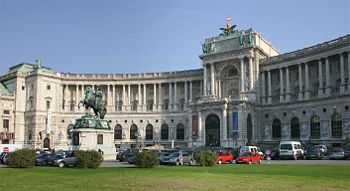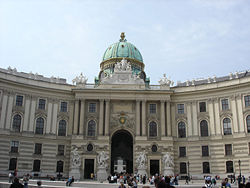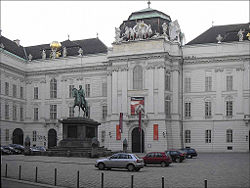Hofburg Imperial Palace
Hofburg Imperial Palace is a palace in Vienna, Austria, which has housed some of the most powerful people in Austrian history, including the Habsburg dynasty, rulers of the Austro-Hungarian empire. It currently serves as the official residence of the President of Austria. It was the Habsburg's principal winter residence, while Schönbrunn Palace was their preferred summer residence. The Palace was the birthplace of Marie Antoinette in 1755.
The Hofburg area has been the documented seat of government since 1279 for various empires and republics. [1]
The Hofburg has been expanded over the centuries to include:

-
- various residences (with the Amalienburg);
- chapels (Hofkapelle, Hofmusikkapelle, Burgkapelle);
- museums (the Naturhistorisches Museum & Kunsthistorisches Museum);
- the Imperial Library (Hofbibliothek now the Prunksaal);
- the treasury (Schatzkammer);
- the national theatre (Burgtheater);
- the riding school (Hofreitschule); and,
- the horse stables (the Stallburg and Hofstallungen).
The Hofburg faces the Heldenplatz ordered under the reign of Emperor Francis Joseph, as part of what was to become a Kaiserforum that was never completed.
Numerous architects have executed work at the Hofburg as it expanded, notably the Italian architect-engineer Filiberto Luchese (the Leopoldischiner Trakt), Lodovico Burnacini and Martino and Domenico Carlone, the Baroque architects Lukas von Hildebrandt and Joseph Emanuel Fischer von Erlach (the Reichschancelry Wing and the Winter Riding School), Johann Fischer von Erlach (the library), and the architects of the grandiose Neue Burg built between 1881 and 1913.
Contents |
History

The Hofburg in Vienna is the former imperial residence. From 1438 to 1583 and from 1612 to 1806, it was the seat of the kings and emperors of the Holy Roman Empire of the German Nation, thereafter the seat of the Emperor of Austria until 1918. Today it is the official seat of the Austrian Federal President.
The oldest sections originate from the 13th century and were primarily constructed by the last of the Babenbergers or by Ottakar II of Bohemia. Previously the castle of the Austrian rulers had been located on the square called "Am Hof," which is near the Scottish Monastery (Schottenstift).
These oldest sections of the castle form a square, surrounding what corresponds somewhat to today’s Swiss Court (Schweizerhof). There situated are a gothic chapel (Burgkapelle), from the fifteenth century, and the treasury (Schatzkammer)[2], which holds, among other objects, the Imperial Insignia of the Holy Roman Empire (Reichskleinodien) and that of the Empire of Austria. The Imperial Music Chapel (Hofmusikkapelle) is also located in this area. This Swiss Court was built during the reign of Emperor Ferdinand I in the style of the Renaissance. Its famous red-black Swiss Gate (Schweizertor) displays the many titles of Emperor Ferdinand I and the insignia of the Order of the Golden Fleece. The lower section of this wing once accommodated the imperial kitchen.
Although not physically connected to the rest of the complex, the Imperial Stables (Stallburg) of the Hofburg were originally built as a residence for the then crown prince Maximilian II. It is said that Ferdinand I did not wish to house his son under his roof, being that Maximilian had veered towards Protestantism. This structure later accommodated the art collection of Archduke Leopold Wilhelm, the art-inclined brother of Emperor Ferdinand III. This collection forms the core of the later Kunsthistorisches Museum from 1889. Only later were the Imperial Stables used to house the imperial horses, and even today it is still used by the Spanish Riding School (Spanische Hofreitschule).
Across from the Swiss Gate is the Amalienburg, named after Amalie Wilhelmine, the widow of Joseph I. However, this wing had already been in use for more than a century, constructed as the Viennese residence of Emperor Rudolph II in the style of the late Renaissance. Of note is the small tower with its dome and the astronomical clock on its façade.
The connection between the Amalienburg and the Swiss Court is the Leopold Wing which was first erected in the 1660s under Emperor Leopold I. The architect was Filiberto Lucchese, but after the Siege of 1683 by the Turks, the wing was rebuilt by Giovanni Pietro Tencala with an additional floor installed. Through its architecture, this wing still bears a connection to the Late Renaissance. It is in this wing that the offices of the Federal President are located. The lower section of this wing as well as that of the Amalienburg served as the enormous wine cellar for the Hofburg.

Originally a free-standing structure, the Imperial Library (Hofbibliothek) was housed on the other side of the complex. Charles VI founded the library, which is now called the Prunksaal, cared for by the Austrian National Library (Österreichische Nationalbibliothek). Its construction was begun by Johann Bernhard Fischer von Erlach and finished by his son Joseph Emanuel in 1735. This magnificent hall contains the book collection of Prince Eugene, an enormous ceiling fresco by Daniel Gran, and statues of emperors by Paul Strudel making this part of the Hofburg its most significant in artistic terms. The exterior decoration with Attika figures was executed by Lorenzo Mattielli in 1726. He placed a statue of Pallas Athene riding on a quadriga above the main entrance. On the left portion of the roof, he situated Atlas, supporting the celestial globe, flanked by Astronomy and Astrology, and on the opposite side, Gaia with the terrestrial globe, flanked by allegories of Geometry and Geography.
An additional father-son collaborative project resulted in the Winter Riding School (Winterreitschule) across from the Stallburg (and where the first Austrian parliament sat in 1848) and in the Imperial Chancellory Wing (Reichskanzleitrakt) across from the Leopold Wing. The latter was originally planned by Johann Lucas von Hildebrandt and accommodated, in addition to the Aulic Council (Reichshofrat), the offices of the Imperial Vice Chancellor (Reichsvizekanzler), who was the de facto prime minister of the Holy Roman Empire since the position of Imperial Arch-Chancellor (Reichserzkanzler)—which the Imperial Vice Chancellor represented—had always been filled by the Archbishop of Mainz since the Middle Ages. After the end of the Holy Roman Empire, this wing housed the apartments of the Duke of Reichstadt (Napoleon II) and later those of Emperor Francis Joseph I.
The Michael Wing was also planned by Joseph Emanuel Fischer von Erlach, and it serves as the connection between the Winter Riding School and the Imperial Chancellory Wing. However, because the old Imperial Theatre (Burgtheater) stood in the way, these plans remained unrealized until Ferdinand Kirschner built the wing from 1889 to 1893, utilizing a slightly altered plan.
More structures and annexes were successively added. Particularly from 1763 to 1769, Nicolaus von Picassi connected the Imperial Library to the other parts of the Hofburg and its other side to St. Augustine’s Church (Augustinerkirche), and he thus created the present Joseph Square (Josephsplatz), one of the most beautiful locations in Vienna. After the renovation of the Albertina in the 1820s by Joseph Kornhäusel, that section became connected to the Hofburg as well.
In 1809, a part of the old bastion adjacent to the old castle was demolished in the course of the Napoleonic Wars. All the way up to the present Ringstraße, new grounds were laid, in which the neoclassical Castle Gate (Burgtor) was integrated. Within the new walls which were erected in 1817, three gardens were laid: the private Imperial Castle Garden (Burggarten), Heroes Square as a lawn with boulevards, and the People’s Garden (Volksgarten) with the Temple of Theseus (Theseustempel), which, along with the Burgtor, was designed by Peter von Nobile. A further addition from this period (already by 1804) is the Hall of Ceremonies (Zeremoniensaal) by Louis Montoyer, which at that time was a protrusion jutting out of the complex. It was quickly regarded as unpleasant and named the Nose (Nase). However, today it is fully integrated into the New Castle (Neue Burg).
Following the enlargement of Vienna after the demolition of the city walls in the 1860s, the Hofburg had its last great expansion. An Imperial Forum (Kaiserforum) was planned—a two-winged structure reaching beyond the Ringstraße, with the twin museums (Kunsthistorisches Museum and Naturhistorisches Museum) as flanks and terminating at the old Imperial Stables (the Hofstallungen, not to be confused with the much older Stallburg) of Fischer von Erlach. The project was led by Gottfried Semper and later by Karl Freiherr von Hasenauer. The museums were completed in 1891, but construction of the rest of the forum dragged on slowly and conflicted since, besides ostentation, no real function could be found for the enormous construction project. In 1913, the south-west wing, the New Castle (Neue Burg), was completed. However, the Imperial Forum was never finished. In its place, Heroes Square (Heldenplatz) and Maria Therese Square (Maria-Theresien-Platz) were laid. The New Castle wing today houses a number of museums (the Ephesus Museum, the Collection of Arms and Armor, the Collection of Ancient Musical Instruments, and the Museum of Ethnology) as well as the reading rooms of the Austrian National Library and the Hofburg Congress Center of international renown. Equestrian statues of the two most important Austrian field marshals, Prince Eugene of Savoy and Archduke Charles, stand at the foci of Heroes Square. On March 15, 1938, Adolf Hitler proclaimed from the balcony of the New Castle onto Heroes’ Square the “Anschluss” of Austria into the Third Reich (Deutsches Reich).
Of note are the equestrian statue of Emperor Joseph II by Franz Anton Zauner at the center of Joseph Square as well as the statue of Francis I in the Inner Castle Court (innerer Burghof) by Pompeo Marchesi. After the completion of Michael Square, two sculpted fountains were installed on its façade: Power at Sea by Rudolf Weyr and Power on Land by Edmund Hellmer.
On the night of November 26/27, 1992, a large fire originated in the Hofburg in the area of the Redoutensäle on Joseph Square. A part of the roof as well as that of the upper floor burned completely down. Its renovation was completed by 1997, and the newly-rebuilt sections now contain wall and ceiling paintings by Josef Mikl.
The Hofburg Palace Silver Coin
The Hofburg Palace is so popular and famous that it was the main motif of one of the most famous silver collectors' coins: the 20 euro Renaissance commemorative coin.
The coin shows the "Swiss Gate" of the palace. This gate bears Ferdinand I's coat-of-arms and titles. It is flanked by two soldiers of the period as a reminder of the unsettled times which saw Vienna besieged by Turkish armies in 1529, as well as the struggles between Protestants and Catholics during the Reformation.
Notes
- ↑ "Hofburg, Wien" (history), Encyclopedia of Austria, Aeiou Project, 2006, webpage: Aeiou-Hofburg-English.
- ↑ The Schatzkammer is an affiliate of the Kunsthistorisches Museum
References
- Translated from de:Hofburg
External links
 Media related to Hofburg at Wikimedia Commons
Media related to Hofburg at Wikimedia Commons- View on Google Maps - includes a short video.
- Website of the Vienna Hofburg Orchestra
- Hofburg Imperial Palace information and photography
- The different sections and museums of the Hofburg
|
|||||||
